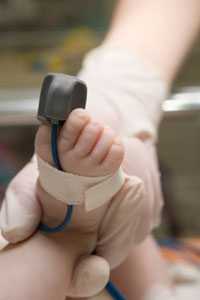New Study Findings: How cost-effective is screening for critical congenital heart defects?

Screening for critical congenital heart defects using a pulse oximeter sensor on a newborn’s foot
The journal Pediatrics has published the first study to look at the costs and health outcomes (cost-effectiveness) of critical congenital heart defects (CCHD) screening in the United States. In this type of analysis the initial cost of doing the screening is weighed against the future health effects and cost-savings (money saved) that could occur because the screening was done. In this study, CDC researchers found that newborn screening for CCHD appears to be good value for the money (cost-effective). You can read the article’s abstract here.
Main Findings from this Study
- The cost of critical congenital heart defects (CCHD) screening compared to infants’ future health benefits and healthcare costs was found to be favorable.
- Screening was estimated to potentially identify 1,189 more newborns with CCHD at birth hospitals in the United States each year (before they are discharged).
- Detection at birth hospitals through screening might prevent 20 infant deaths in the United States each year.
- Newborn screening for CCHD might cost $13.50 per newborn based on cost estimates from New Jersey.
- A net cost estimate of $6.30 per newborn takes into account the expected cost savings that occur when readmission to a hospital is avoided because the CCHD diagnosis is made at the birth hospital rather than after discharge, using CCHD hospital cost estimates from Florida.
- If hospitals were to use reusable screening equipment, the net cost could be reduced to about 50¢ per newborn.
- Combining estimates of numbers and hospitalization costs of late-detected CCHD and potentially avoidable deaths from Florida, plus screening cost estimates from New Jersey, it is projected that screening may cost approximately $40,000 per life-year saved, which is considered cost-effective.
Basics about Critical Congenital Heart Defects
What are critical congenital heart defects?
Congenital heart defects are the most common type of birth defect in the United States, affecting nearly 1% of―or about 40,000―births per year. About 1 in 4 babies born with a heart defect has a critical congenital heart defect (critical CHD, also known as critical congenital heart disease).1 Babies with a critical CHD need surgery or other procedures within the first year of life.
How can newborn screening help babies with critical CHD?
Some babies born with a critical CHD appear healthy at first and can be sent home before their heart defect is detected. These babies are at risk of having serious complications within the first few days or weeks of life and often require emergency care. Newborn screening can identify some of these babies so they can receive care and treatment that can help prevent disability or early death.
Newborn screening for critical CHD involves a simple bedside test to determine the amount of oxygen in a baby’s blood. Low levels of oxygen in the blood can be a sign of critical CHD. Critical CHD screening has begun in some states, and laws requiring this screening have been proposed or passed in other states. You can see what is happening in your state here.
- Several states have implemented or are considering newborn CCHD screening. Future analyses of data from states that conduct routine screening will help to refine these estimates.
About this Study
Researchers compiled information from previous studies to model the cost-effectiveness of newborn screening for CCHD.
More Information
To learn more about congenital heart defects, please visit https://www.cdc.gov/ncbddd/heartdefects/.
To learn more about screening for critical congenital heart defects, please visit https://www.cdc.gov/ncbddd/heartdefects/screening.html.
Key Findings Reference
Peterson C, Grosse SD, Oster ME, Olney RS, Cassell CH. Cost-Effectiveness of Routine Screening for Critical Congenital Heart Disease in US Newborns. Pediatrics. 2013 [epub ahead of date]
Heart Defects: CDC Activities
Centers for Disease Control and Prevention (CDC) works to identify causes of congenital heart defects (CHDs) and ways to prevent them. We do this through:
- Surveillance or disease tracking:
- State programs: CDC funds and coordinates the Metropolitan Atlanta Congenital Defects Program (MACDP). CDC also funds 14 population-based state tracking programs. Birth defects tracking systems are vital to help us find out where and when birth defects occur and whom they affect.
- Adolescents and adults: CDC recently funded 3 projects to track congenital heart defects among adolescents and adults in order to learn about their health issues and needs across the lifespan.
- Research: CDC funds a large study of birth defects called the National Birth Defects Prevention Study. This study is working to identify risk factors for birth defects, including heart defects.
- Collaboration:
- CDC is assessing states’ needs for help with CCHD screening and reporting of screening results. CDC worked with New Jersey and Georgia to assess their ability to track CCHD screening. CDC is also helping states and hospitals to better understand how much hospitals spend for each baby screened.
- CDC promotes collaboration between birth defects tracking programs and newborn screening programs for CCHD screening activities. State birth defects programs collect data on CHDs and could help evaluate the effectiveness of screening by looking at false positives (babies who failed the CCHD screening but do not actually have a CCHD after further evaluation) and false negatives (babies who passed the screen suggesting there was no CCHD but actually did have a CCHD).
- CDC provides technical assistance to the Congenital Heart Public Health Consortium and to states receiving funding from the Health Resources and Services Administration (HRSA) for CCHD screening activities.
References:
1. Oster M, Lee K, Honein M, Colarusso T, Shin M, Correa A. Temporal trends in survival for infants with critical congenital heart defects. Pediatrics. 2013. [epub ahead of print].
- Page last reviewed: February 23, 2016
- Page last updated: February 23, 2016
- Content source:


 ShareCompartir
ShareCompartir